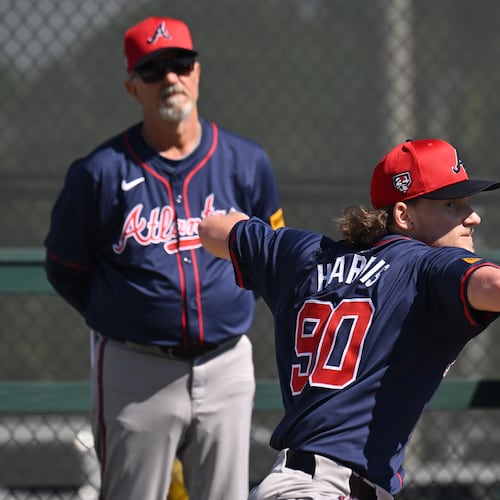Watching Mike Foltynewicz and Max Fried against the Twins, we all could only wonder how good this Braves rotation could be with those two at their peak. Watching Dallas Keuchel against the Marlins on Thursday, we were reminded it’s near impossible to get all five arms clicking at the same time.
Therein lies the Braves’ most unanswerable question: When October rolls around, who will they trust? We won’t know until the day comes, but the answer seems to change every turn through the order.
Foltynewicz is the biggest wild card. But he impressed in his return from Triple-A banishment. He allowed three runs over 5-1/3 innings, an average line that doesn’t do that performance justice. Foltynewicz looked confident. His velocity was all-the-way back. His slider, the weapon that derailed him earlier in the season, was a menace again.
It provided endless intrigue heading into his second start, slated for Sunday in Miami. In the eyes of Braves general manager Alex Anthopoulos, Foltynewicz has grown as a pitcher through his disastrous first half.
“It felt like he pitched more than last year, when he could just overpower guys,” Anthopoulos said. “Going through his challenges early in the year, he had to throw his change-up a little more. He had to throw his curveball a little more. He had to mix and match more because the slider didn’t show up every time.”
We all await Foltynewicz’s next outing, which carries some weight. If Foltynewicz is promising again, the perception of the Braves changes. Anthopoulos and the organization won’t think ahead to October – but we can. And plugging a revived Foltynewicz into those plans makes the Braves a significantly better club.
“It’s still August, you know how quickly things can change,” Anthopoulos said. “I’m anxious to see Folty’s next start. He had that outing in St. Louis that was fantastic. The key for him is the slider. He threw a lot of them because they were quality. He didn’t throw a lot of them early because they were hanging.”
Meanwhile, Fried has hit his stride. His latest start – 5-1/3 innings, three runs, 10 strikeouts – also was better than his line. The left-hander again appears past his blister issue, but the volatility of that issue always will make for wavering confidence.
Keuchel’s struggles leave a growing concern. He doesn’t throw hard, which requires him to exhibit excellent accuracy. Getting smacked for eight runs and leaving in the fourth inning against the Marlins is, well, not a shining example of reliability.
The southpaw’s ERA is inching closer to 5.00 after 10 starts. The Braves believe in Keuchel and trust he’ll get it sorted out – catcher and friend Brian McCann should help that cause – so it’s not like there’s any panic. But if the status quo persists, there won’t be much discussion about what it will cost to re-sign the former Cy Young winner.
Mike Soroka’s innings aren’t a concern, Anthopoulos reiterated Thursday. The Braves have maintained they’ll take their youngsters’ workload on a start-by-start basis. Manager Brian Snitker has lifted Soroka and Fried early at times, trying not to push them when unnecessary.
And then there’s Julio Teheran, who’s quietly been the team’s second-most reliable starter. Evaluating him through postseason glasses is a different story, however, and how Teheran factors in then will be determined by his performance and the opponent.
As many pointed out following the team’s active trade deadline, the rotation is still a gamble. Letting Kevin Gausman go wasn’t a loss – he was pitching terribly and had been essentially phased out – but banking on Foltynewicz is risky, even if you believe he’ll bounce back (I am among that group).
So while we wait out the final two months, I expect the dominating headline to be the rotation. Soroka’s and Fried’s innings, Teheran’s legitimacy, Keuchel’s performance and Foltynewicz’s stability; the Braves can only hope by October, those puzzles have been solved.
About the Author
Keep Reading
The Latest
Featured


